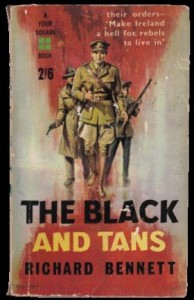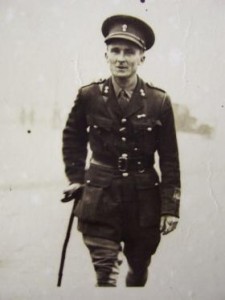Telling tales: the story of the burial alive and drowning of a Clare RM in 1920
Published in 20th-century / Contemporary History, Features, Issue 1 (Jan/Feb 2010), Revolutionary Period 1912-23, Volume 18, World War I
Richard Bennett’s The Black and Tans (1959)—one of several books that repeated the burial and drowning story.
On the morning of 22 September 1920, four volunteers from the IRA’s West Clare brigade gathered at a level crossing at Caherfeenick, near Doonbeg. Presently, they heard an approaching Ford two-seater—the object of their attentions. The driver was local resident magistrate Captain Alan Cane Lendrum MC, a native of County Tyrone, a former rubber-planter in Malaya and a veteran of the First World War, in which he had served with the Royal Inniskilling Fusiliers. Following actual or perceived resistance, a volunteer discharged his gun, seriously wounding Lendrum in the head. IRA brigade chief-of-police Willie Shanahan arrived on the scene. Being the only volunteer who knew how to drive, Shanahan disposed of the car. In direct consequence, he and Michael McNamara, captain of the Doonbeg company, would soon pay the ultimate price at the hands of Crown forces.
Published accounts of the magistrate’s death were quickly embellished. Lendrum’s captors allegedly dragged the wounded magistrate to a nearby beach, where they buried him up to his neck and callously left him to drown in the incoming tide. On their return the next morning, they found him still alive, and they allegedly dug him up and reburied him closer to the shoreline. Later accounts added the gruesome detail that the victim was deliberately faced towards the advancing tide, so that he might witness his own impending fate. These lurid new versions soon became entrenched as ‘the truth’ of what happened, and they have remained unchallenged until the recent discovery of Lendrum’s death certificate.
Drowning story takes on a life of its own
The first account of the drowning atrocity appeared in the highly regarded Edinburgh-based Blackwood’s Magazine in May 1921 and was loosely based on the ambush and death of Captain Lendrum. Later the same year, the story was reissued by Blackwood’s in Tales of the RIC, a book of anonymous short stories. This was an ideal propaganda vehicle, enjoying wide circulation at home and abroad. An ad in The Fortnightly (vol. 110) declared: ‘Read Tales of the RIC and you will there find THE FACTS and no longer be bored’. The ‘facts’ in question made for gruesome reading: ‘And the next flood tide put an end to a torture the like of which Lenin and Trotsky could hardly exceed for sheer malignant devilry’.
Because it presented a macabre vignette of the callous cruelty of the IRA, this story was retold as fact by successive commentators of varying backgrounds. In 1951 Sir Christopher Lynch Robinson, in The last of the Irish RMs, referred to a magistrate being ‘buried alive in the sands’ in Galway. In The Black and Tans (1959) Richard Bennett repeated the story, listing Tales of the RIC as his source in his bibliography. Rex Taylor’s version in Assassination: the death of Sir Henry Wilson and the tragedy of Ireland (1961) baldly stated that Lendrum was buried alive on the beach: ‘In all the history of Irish sadistic violence, there is nothing to equal this atrocity committed against a gallant and decent man’. The story was recycled through the years in several publications, including Life World Library: Ireland by Joe McCarthy (1964), The Irish constabularies 1822–1922 by Donal J. O’Sullivan (1999) and A history of Ireland by Peter and Fiona Somerset Fry (1991). Tim Pat Coogan in Ireland since the Rising (1966) gave it the full treatment, including the reburial facing the tide. A fictional interlude was provided by best-selling novelist Eilis Dillon, who reintroduced the story in The interloper (1967). ‘I was staying in a house in County Clare . . . The men I was with were rejoicing—that’s the only word I can use—in the lingering death inflicted on a resident magistrate, buried in the sand and left to drown in the rising tide on a desolate shore.’ A character in J. G. Farrell’s highly regarded novel Troubles (1970) is singled out for a similar fate.
Impact in the North

Captain Alan Cane Lendrum MC, resident magistrate, a native of County Tyrone, a former rubber-planter in Malaya and a First World War veteran who served with the Royal Inniskilling Fusiliers. (Geoff Simmons)
The content and timing of these accounts of the ‘barbarity’ had a collateral effect in the North. Generations of the magistrate’s relatives and friends may have gone to their graves believing that the horrific drowning had actually happened. In Police casualties in Ireland 1919–1922 (2000) Richard Abbott referred to resultant ‘serious disturbances and lawlessness that spanned both the political and religious divides’ in the North. Arthur Hezlet fleshed out this oblique comment in his The ‘B’ Specials: a history of the Ulster Special Constabulary (1972): ‘In Ulster itself tension was further increased by the murder of Captain Lendrum, a resident magistrate . . . from Trillick in Co. Tyrone’. Hezlet detailed the burial and reburial, followed by the dead body being brutally discarded on a manure heap. He opined: ‘I make no apology for recalling this atrocity . . . for unless some such cases are mentioned it is difficult to understand the pressures and tensions of the time and the hatreds that exist in Ireland to this day’. This work was published in one of the darkest years of the recent Troubles, with close to 500 people losing their lives. In 1989 Kevin Myers, writing with characteristic gusto in the Irish Times, rehashed the standard ‘burial on the beach’ story, although he honourably retracted it later, blaming Basil Clarke and his propaganda machine for the misinformation.
Reaction in Clare
In West Clare, people shrugged off reports of such an atrocity: ‘Sure, everybody knows that didn’t happen’. Nevertheless, there was a sense of helplessness in the absence of definitive proof to the contrary, and the extended families of the men involved had to live with the shadow of this cruel atrocity hanging over them. It was not just outsiders who repeated the story. Fr Patrick Gaynor ministered locally and was a member of the supreme executive of Sinn Féin. His memoirs, written between 1945 and 1949, were published in 2003 as The Gaynors of Tyone by Eamonn Gaynor, who wrote: ‘After a subsequent autopsy the police claimed that he had been buried while still alive, that death was due to drowning’. In A history of County Clare (2003) Seán Spellissy gave a similar account. Brian Dinan repeated the ‘burial, reburial and drowning’ account in Clare and its people: a concise history (1987). A recent treatment of the period, Blood on the banner by Padraig Óg Ó Ruairc (2009), stated that Willie Shanahan, ‘thinking Lendrum was already dead, took him to a lake, tied a weight to him and threw him into the water, where the unconscious captain died of drowning’.
![Captain Lendrum’s death certificate—under ‘Certified Cause of Death and Duration of Illness [column] (8)’ is clearly written ‘murder by shooting by persons unknown’. (National Archives)](https://www.historyireland.com/wp-content/uploads/2013/02/76_small_1265288809.jpg)
Captain Lendrum’s death certificate—under ‘Certified Cause of Death and Duration of Illness [column] (8)’ is clearly written ‘murder by shooting by persons unknown’. (National Archives)
On 5 October 1920 in Kilrush, in lieu of an inquest, a court of inquiry was held into the death of Captain Lendrum. The death certificate, informed by this court, clearly stated that death resulted from ‘murder by shooting by persons unknown’. This crucial finding was never subsequently mentioned in the proliferating published accounts of the events of that fateful day. And so it transpires after all these years that there was no drowning, no burial alive and no tidal atrocity in Doonbeg in 1920. It has taken almost a century to dispel the fabrications surrounding the death of Alan Lendrum. For some, the wait has been worthwhile. For many, it is too late. HI
Eoin Shanahan is a teacher at St Patrick’s National School, Drumcondra. He is a nephew of Willie Shanahan and acknowledges the contribution of Geoff Simmons, great-nephew of Alan Lendrum, in researching these events.
Further reading:
D. Fitzpatrick, Politics and Irish life, 1913–1921: provincial experience of war and revolution (Cork, 1998).
J.W. Foster, Irish novels, 1890–1940: new bearings in culture and fiction (New York, 2008).
B.P. Murphy, The origins and organisation of British propaganda in Ireland, 1920 (Aubane, 2006).
















